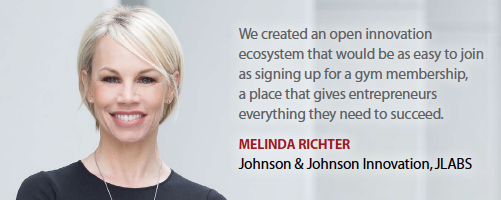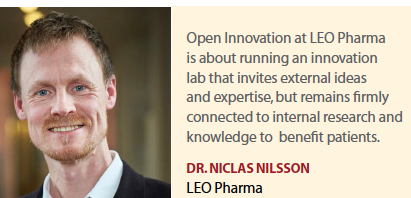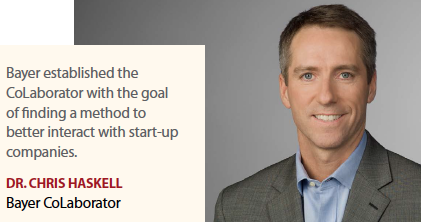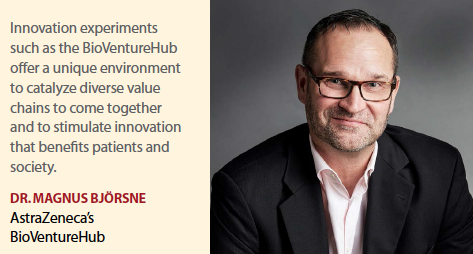Innovative or collaborative partnerships in pharma are being touted by some as the “new normal." Certainly, this is true of several pioneering pharmaceutical companies in the space, but authentic, independent or open-source collaborations are still a minority in the life-sciences ecosystem. The bright spot is that there are several companies that have created in-house innovation labs, and their view is that these models are critical to bringing newer treatments to the market faster. These collaborations create an innovative environment ripe for producing novel treatments that one organization could not generate on its own.
The concept behind the incubator has been around a number of years and has been in place in other industries for decades. Many innovative companies outside of the pharma world have recognized that  huge organizations are hard places for innovation to flourish and that new ideas succeed when there is the enthusiasm and focused culture inherent in a start-up organization, with the benefits of a protective environment.
huge organizations are hard places for innovation to flourish and that new ideas succeed when there is the enthusiasm and focused culture inherent in a start-up organization, with the benefits of a protective environment.
Earlier this year, IDEA Pharma produced its Pharmaceutical Innovation Index, which highlights innovation at the clinical, regulatory, and commercial levels within pharma companies. This year’s top 10 companies include: Biogen, AbbVie, Gilead Sciences, Johnson & Johnson, Takeda, Baxter, Merck & Co., Novo Nordisk, Bristol-Myers Squibb, and Celgene.
According to IDEA Pharma CEO Mike Rea, it was an exciting year for innovation, and there are various models playing out in pharma, including partnering with external sources to get the job done.
“Most of our great medicines were not the product of an internal discovery and development unit," Mr. Rea says.
There appears to be three common strategies in terms of innovative business development in the industry: truly organic incubators with no ties to pharma; pharma models that include a start-up  mentality; and companies that are doing the same thing in terms of partnerships but have renamed their efforts as innovative.
mentality; and companies that are doing the same thing in terms of partnerships but have renamed their efforts as innovative.
“Some companies are incubators in the truest sense of the word; some are unfortunately incubators in name only," Mr. Rea says.
Two examples of completely organic incubators that have no links to traditional pharma are Accelerator Corp. and Harlem Biospace.
Based in Seattle, Accelerator is a capital investment and management firm for emerging biotechnology opportunities.
Formed by a syndicate of top-tier venture capital investors and supported by a consortium of world-class research institutions, Accelerator identifies, evaluates, finances, and manages the commercialization of technologies and assets sourced from a broad range of proprietary sources.
Located in the heart of Manhattan is Biospace, an organic incubator for early-stage biotech start-ups. Start-ups receive space, as well as access to lab equipment, wet lab space, and biotech lawyers. The goal is to help streamline the process of turning ideas from local research universities and health scientists into viable businesses.
On the pharma side, JLABS would be an example of an innovation lab that is functioning with a start-up mentality, according to Mr. Rea.
“JLABS has a deeply understood start-up culture, and has exquisitely tuned its model to the new world," he says. “This is an unusual model within pharma, where most companies have preferred ‘sameness with difference’ — doing something that they might have always done, but under a different name."
Pharma companies functioning within this premise, Mr. Rea says, just don’t get the nature of  innovative collaboration. Their approach is to bolt on a structure that can’t stand on its own, and doesn’t use the strengths of the old structure enough.
innovative collaboration. Their approach is to bolt on a structure that can’t stand on its own, and doesn’t use the strengths of the old structure enough.
“This lack of clarity of purpose is the most common problem we see," he adds. “To be able to develop medicines for tomorrow, pharma can’t keep applying yesterday’s thinking."
Mr. Rea uses the metaphor of building a faster car rather than a better car to explain. “The innovation we need is not faster cars, but to make cars that don’t need traditional engines," Mr. Rea adds. “We need to create a Tesla, while the industry is building Corvettes: instead of just putting more and more early-stage molecules into an inefficient engine, we need to re-imagine the whole car end-to-end. One of those ends starts with rethinking early-stage discovery and the incentives that the industry currently applies to this area of drug development."
JLABS
Melinda Richter, global head of Johnson & Johnson Innovation, JLABS (JLABS), has made sure that JLABS is reinventing how incubating is done. Established five years ago, JLABS was one of the first pharma entities to create a collaborative space with no strings attached for its participants. What was once an experiment is now an established model that spans the globe with eight physical sites, educational programs, professional services, mentoring, and QuickFire Challenges. According to Ms. Richter, JLABS creates an environment for entrepreneurs to succeed in a difficult industry that touches everyone — healthcare. The challenges for entrepreneurs in this space are significant, with steep barriers to entry, high risk of failure, and lengthy development times.
“Our solution was to create an open innovation ecosystem that would be as easy to join as signing up for a gym membership; a place that gives entrepreneurs everything they need to succeed, without dictating what that success should look like; and providing them with the advice, relationships, and services only available to big companies," Ms. Richter says. “In short, we want to: lower costs, remove hurdles, and provide support. And this model has been, and continues to be, a great success."
By removing the need to devote so much time and budget to operations, facility management, technical support, and equipment purchases that independent companies often have to contend with, Ms. Richter says the JLABS’ entrepreneurs can now focus more of their time and money on what matters most — their science. With mentorship from the vast J&J network on development and commercialization, innovators are designing smarter companies that are accelerating their solutions to patients.
“What’s unique is that we offer entrepreneurs residency with no strings attached," Ms. Richter says. JLABS companies retain complete intellectual property and equity in their companies and have the ability to do deals — or not — with J&J or any of its competitors.
“We wanted to make it financially attractive for the best talent to get in the business of health," she adds.
Collectively, JLABS companies have secured $9.4 billion through financings and strategic relationships. JLABS companies have done deals with many other competitive companies and VC firms and 71 companies are executing deals with members of the Johnson & Johnson family of companies as well, including five IPOs, eight acquisitions, and seven collaborations between JLABS companies.
“Over the course of five years, we’ve had 312 companies that have come through our doors, with 121 alumni, 80% of which are still in business," Ms. Richter says.
LEO Pharma
Another pioneer in the collaborative space is LEO Pharma. As a foundation-owned pharmaceutical  company, it has a well-established product portfolio in dermatology and skin inflammation diseases. LEO Pharma is interested in exploring new opportunities and ways of working with external research partners. To achieve this, the company has established an open innovation and collaborative space where unique research tools are made available to external partners.
company, it has a well-established product portfolio in dermatology and skin inflammation diseases. LEO Pharma is interested in exploring new opportunities and ways of working with external research partners. To achieve this, the company has established an open innovation and collaborative space where unique research tools are made available to external partners.
“Open Innovation is a collaborative space, created to explore partnerships and the latest research using some of LEO Pharma’s unique and disclosed scientific resources," says Niclas Nilsson, Ph.D., head of R&D Open Innovation at LEO Pharma. “It provides external partners with the unique opportunity to test their molecules for disease-modifying effects, without the need to disclose confidential information or relinquish intellectual property. The partner owns the data and is under no business obligation to LEO Pharma — for free, no strings attached."
In return, LEO Pharma is in a position to evaluate the efficacy of those molecules, and can reach out to the partner to discuss extending the relationship if the generated data look promising.
“As we see it, Open Innovation is about running an innovation lab that encourages and embraces external ideas and expertise, but remains firmly connected to internal research and knowledge for the benefit of patients," he says.
LEO Pharma’s Open Innovation has been operating for more than two years, although the setup began three years ago. In that time it has collaborated with about 50 partners and evaluated more than 500 molecules for their disease-modifying effects in phenotypic assays. The lab operates with no specific funding because the model is based on in-kind scientific contributions and makes use of scientific processes that are already going on internally. Currently, there are two full-time employees; they oversee the practical running of the program and promote it, and they tap into resources and expertise across the wider organization, including scientific research, business development, pipeline sourcing, legal and communications, among others.
“If there is a business case for us to devote funding to extend a research avenue, we explore that on a case-by-case basis after the molecules have been tested in our disease-relevant assays," Dr. Nilsson says.
There have been at least five follow-ups from these partnerships. Of the 500-plus molecules evaluated, which is a huge success in its own right, about 10% have generated data that LEO Pharma would consider exciting.
 “For us, the biggest success is how far we’ve come in altering the internal culture at LEO Pharma toward an open and innovative mindset," Dr. Nilsson says. “We are a big part of the LEO Pharma innovation ecosystem, and together with the other innovation entities —LEO Innovation Lab and LEO Science & Tech Hub — we are driving new ways of thinking and working with external partners."
“For us, the biggest success is how far we’ve come in altering the internal culture at LEO Pharma toward an open and innovative mindset," Dr. Nilsson says. “We are a big part of the LEO Pharma innovation ecosystem, and together with the other innovation entities —LEO Innovation Lab and LEO Science & Tech Hub — we are driving new ways of thinking and working with external partners."
Bayer CoLaborator
At Bayer, the CoLaborator allows for a collaborative process with shared risks and rewards that addresses the need for new approaches to research partnerships in today’s environment. The goal is to go beyond the traditional incubator to a true collaboration between Bayer scientists and young companies.
Christopher Haskell, Ph.D., leads Bayer’s West Coast Innovation Center, based in the company’s U.S. Innovation Center located at Mission Bay/San Francisco. Dr. Haskell is also responsible for the development of the CoLaborator, which opened in the fall of 2012. The CoLaborator houses a number of start-up life-sciences firms.
“We opened the first CoLaborator in Mission Bay just over five years ago, with the goal of finding a method to better interact with start-up companies that are so prevalent here," Dr. Haskell says. “The traditional model of development partnerships through sporadic interactions just didn’t prove very fruitful. By selecting companies that we identified as developing tools, technologies, and therapeutics that could be of high interest to Bayer and then having them work in a space that is in close proximity to us we could foster dialogue that could potentially lead to fruitful interactions and partnerships."
Dr. Haskell says it was the move to San Francisco and the proximity to the many start-up companies that inspired Bayer to create the CoLaborator.
“Ten years ago, I would not have guessed we’d be involved in an innovation incubator," he says. “Back then, there were a couple of corporate incubators that had the more traditional model of a venture incubator, where there was some form of equity investment and very tight ties to the funding companies," he says. “When we came to Mission Bay, we saw how many start-up companies there are and recognized that there was potential for engagement."
In addition, there were other incubators, especially the QB3 incubator, University of California’s hub for innovation and entrepreneurship in the life sciences, which were starting to prove that start-up companies were leading to impactful companies.
According to Dr. Haskell, the CoLaborator is a bit different from other incubators in that it establishes long-term relationships with the select number of start-up companies and works with them as they advance their technology forward.
At some cohort-based incubators, companies get their start but then they move on very quickly. Places such as YCombinator, which provides seed funding for start-ups, try to get the companies up to speed quickly, and once that goal is reached, the start-ups move out on their own or are bought by a larger company.
Bayer decided to choose companies that it thinks will have a big impact on healthcare, and then seriously invest in developing a long-term relationship.
“We’ve welcomed seven companies into the CoLaborator," Dr. Haskell says. “Currently, of this original seven there are five still in the space in one way or another. And we have worked with four of these companies in some form of collaboration."
The CoLaborator’s physical space is currently being expanded, which will allow for a total of 12 companies soon.
“It’s a model that Bayer believes in," Dr. Haskell adds. Bayer launched its CoLaborator in Berlin in 2014 and most recently, the Crop Science CoLaborator in late 2017.
Bayer has several types of innovative programs in addition to the CoLaborator, including a novel crowd-sourcing initiative called Grants4Targets.
“With this initiative we aim to combine expertise from academic researchers and researchers in the pharmaceutical industry to identify and validate novel drug targets and biomarkers," Dr. Haskell explains. “Bayer’s open innovation programs like Grants4Targets and the CoLaborator allow us to interact in an innovation ecosystem and help cultivate and become involved."
AstraZeneca’s BioVentureHub
AstraZeneca’s BioVentureHub was established three years ago and is a unique private-public partnership model. Its goal is to develop an open-innovation ecosystem to further strengthen competitiveness and dynamism in the life-sciences industry in Sweden and Scandinavia. There are currently 24 companies and one academic group in the BioVentureHub. It continues to grow and deliver on the ambition to combine life-science value chains and stimulate entrepreneurial mindsets. The hub added three new companies in November and eight new companies overall in 2017. Five-year funding is distributed between Vinnova (the Swedish innovation Agency), Region Västra Götaland, Carl Bennet AB, the City of Gothenburg, and AstraZeneca.
“Embedded at the heart of AstraZeneca Gothenburg is the BioVentureHub, which gives emerging life-sciences companies and academic groups the opportunity to co-locate and interact with AstraZeneca’s scientists and work with state of-the-art lab facilities, as well as with each other," says Magnus Björsne, Ph.D., CEO, AstraZeneca’s BioVentureHub. “Companies that are accepted to be part of the BioVenturehub are in the heart of one of the most knowledgeable research facilities in Scandinavia with access to research resources that they would never have been able to establish on their own."
Companies within the BioVentureHub have conducted more than 30 clinical trials to date. Three successful IPOs and one product approval have been delivered. Additionally, several companies have grown beyond their entry into the BioVentureHub. The research environment also offers unique opportunities for companies to engage in inter-hub collaborations.
The Impact of Innovative Labs on the Industry
The advance of collaborative spaces for life-sciences — whether working on new forms of treatment, patient-support technology, or other novel ideas — is impacting the industry in several ways. Most obviously, new approaches to treating disease may emerge faster, and in more cost-effective environments, to improve patient outcomes. The collaboration model may slowly change the close-to-the-vest IP paradigm of the industry in noncompetitive situations, opening the doors to greater innovation, and allow younger companies with great ideas to bring their knowledge to the table. Overall, innovation labs appear to be a win-win-win: for the participants, the sponsoring party, and patients.
Dr. Haskell from the CoLaborator believes that investing in others is also investing in the future of the industry. “At the core of what many of the larger pharma companies are doing is — in a cooperative way — investing in developing the ecosystems as well as funding individual companies," he says. “Many of the companies that are coming up are taking high-risk, innovative approaches to address unmet needs. Participating in the ecosystem, serving on advisory boards, funding the incubator, and giving feedback to these companies is a great way to help make sure that all of the great ideas that are in these small companies are better able to advance."
Innovation experiments such as the BioVentureHub offer a unique environment to bring diverse value chains together and to stimulate innovation that benefits patients and society. Generating value in the life-sciences industry will increasingly be about cross-value chain innovation — combining devices, drugs, diagnostics and digital health, Mr. Björsne says. This type of innovation needs to continue, especially within established companies.
“Pharma companies have a great reputation for conducting scientific experiments," he adds. “They are less well-known for their innovation experiments."
LEO Pharma Open Innovation views its role as a facilitator for greater innovation that challenges established ways of thinking internally as well as externally.
“We invite anyone to partner with us and test their molecules to see if they might be disease-modifying," Dr. Nilsson says. “It’s hard to imagine how we could be more open to innovation than that. Our platform has a number of potential values, including the potential to fuel our pipeline, increase our disease understanding, quickly adapt our research capabilities based on patients’ needs, and partner with external groups with tangential or perhaps even completely unrelated expertise that we couldn’t collaborate with through any other mechanism. This approach is fueling our innovation, and that means solving problems in new and better ways."
As part of the broader Johnson & Johnson Innovation group, JLABS offers a broad array of programming, expertise, advice, and other intangible assets to innovators across the biopharmaceutical, medical device, consumer, and healthtech sectors.
“Our goal is to enable, empower, and inspire these innovators so they can deliver much-needed healthcare solutions to people all over the world, at a speed of innovation that emulates other industries," Ms. Richter says. “Getting those solutions to the people who need them is why innovation labs are important to the industry and its customers."
Dr. Haskell notes that over the past few years he has noticed within the laboratory a more cohesive, open ecosystem developing that could have a great influence on the industry as a whole.
“We are noticing that the interaction between the companies is a very interesting dynamic," he says. “Simply by facilitating and bringing these companies together, we are creating an ecosystem that is self-perpetuating."(PV)
~~~~~~~~~~~~~~~~~~~~~~~~~
The Importance of Innovation in Medical Safety
 Joanne Waldstreicher, M.D., Chief Medical Officer, Johnson & Johnson
Joanne Waldstreicher, M.D., Chief Medical Officer, Johnson & Johnson
With a keen focus on finding new ways to advance medical safety, the Johnson & Johnson Office of the Chief Medical Officer partnered with Johnson & Johnson Innovation in its latest QuickFire Challenge: Advancing the Safe Use of Healthcare Products. The Challenge called for potentially game-changing, early-stage, innovative ideas to help advance the safe use of healthcare products. Like all the QuickFire Challenges, the program comes out of J&J’s core belief that great innovations can come from anywhere, even outside its own company.
“When we hear about innovation in healthcare, we tend to think of new treatments," says Joanne Waldstreicher, M.D., chief medical officer, Johnson & Johnson. “However, innovations in safety can also be as important and impactful as those that provide additional efficacy. This is why challenging and supporting researchers and innovators to develop new approaches to safety is so critical."
The QuickFire Challenge received almost 100 submissions, which speaks to the importance of medical safety and the opportunity to innovate around safety. Because estimates have shown that medication errors cause at least one death every day and injure about 1.3 million people each year, Dr. Waldstreicher’s office is eager to support a solution that could positively impact health outcomes.
The winner, CertaDose Inc., created a color-matching pediatric dosing system for injectable medicines directly aimed at reducing dosing errors in our most vulnerable patients, children. While the idea for the product is simple, the safety implications are significant. In addition, there is potential for this innovation to be used more broadly with other pediatric treatments. As the winner, CertaDose will receive funding, mentorship from two colleagues within the Johnson & Johnson Office of the Chief Medical Officer, and lab space in JLABS.
The Johnson & Johnson Office of the Chief Medical Officer takes an evidence- and science-based as well as an ethics- and values-driven approach to medical safety. Its goal is to enhance outcomes. “Meaningful advancement in medical safety helps us meet the needs of the patients and consumers we serve," Dr. Waldstreicher says. “And by being collaborative and open to innovations in medical safety, regardless of where those innovations originate, we aspire to do even more."

















